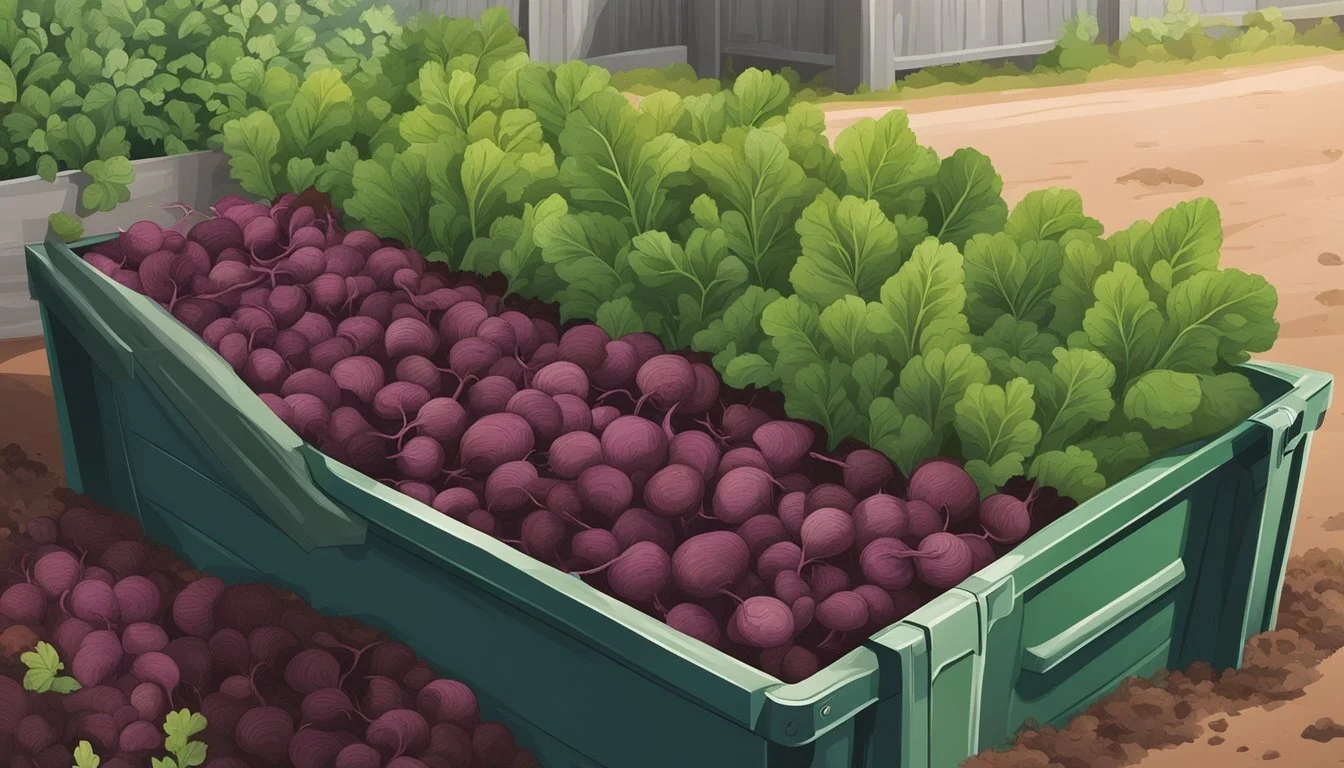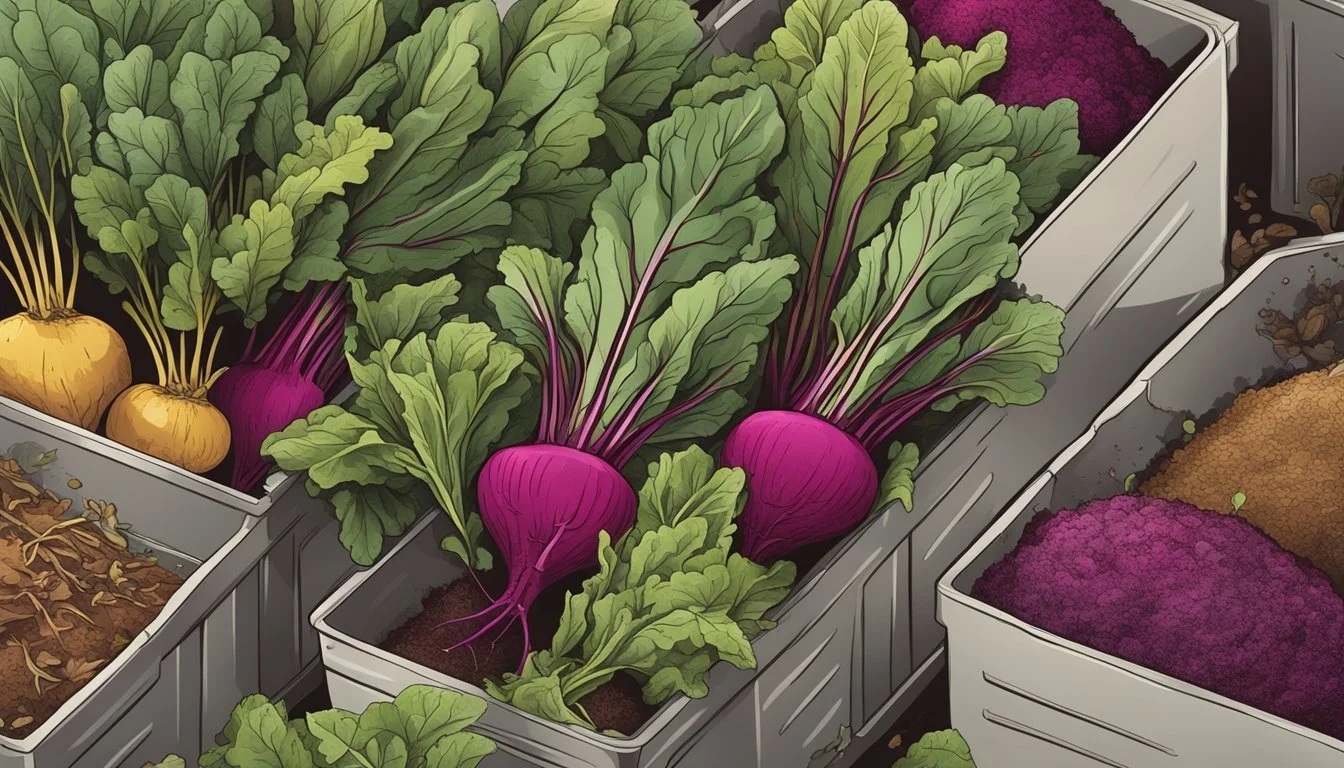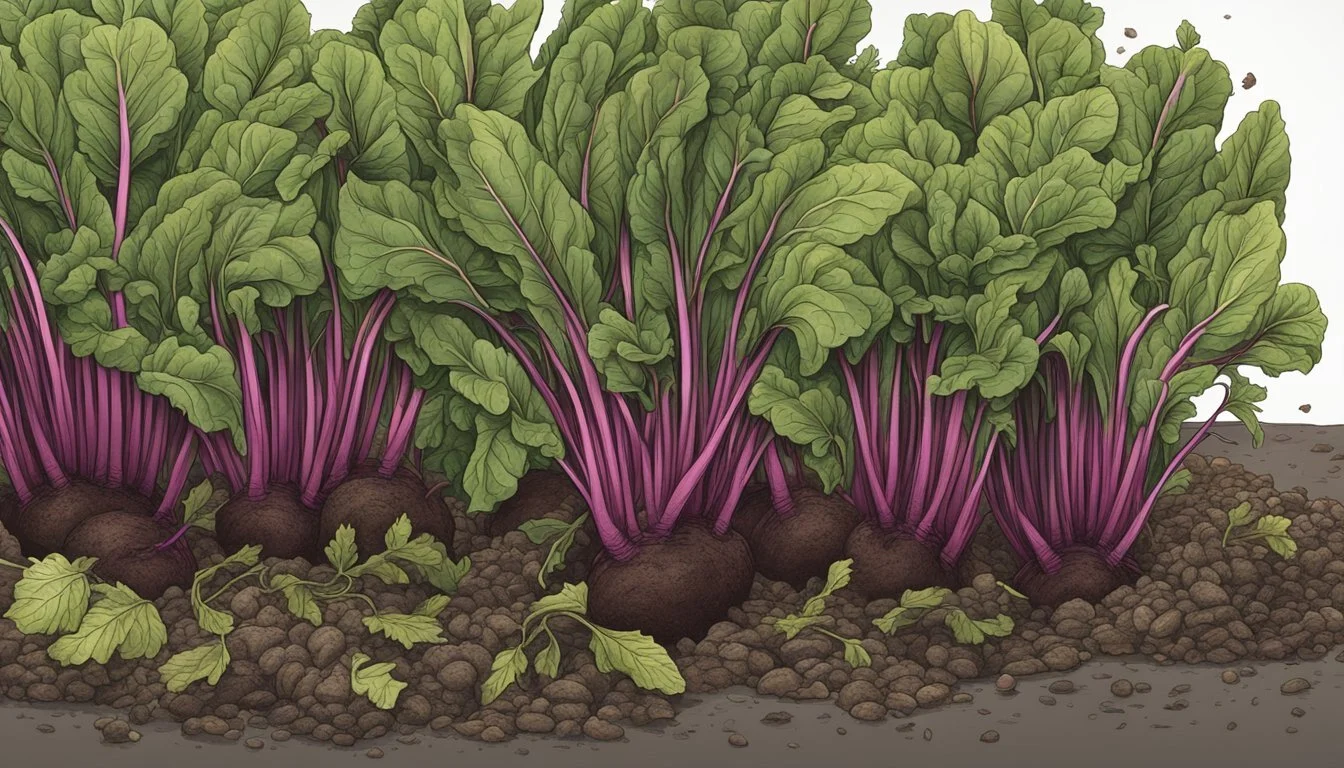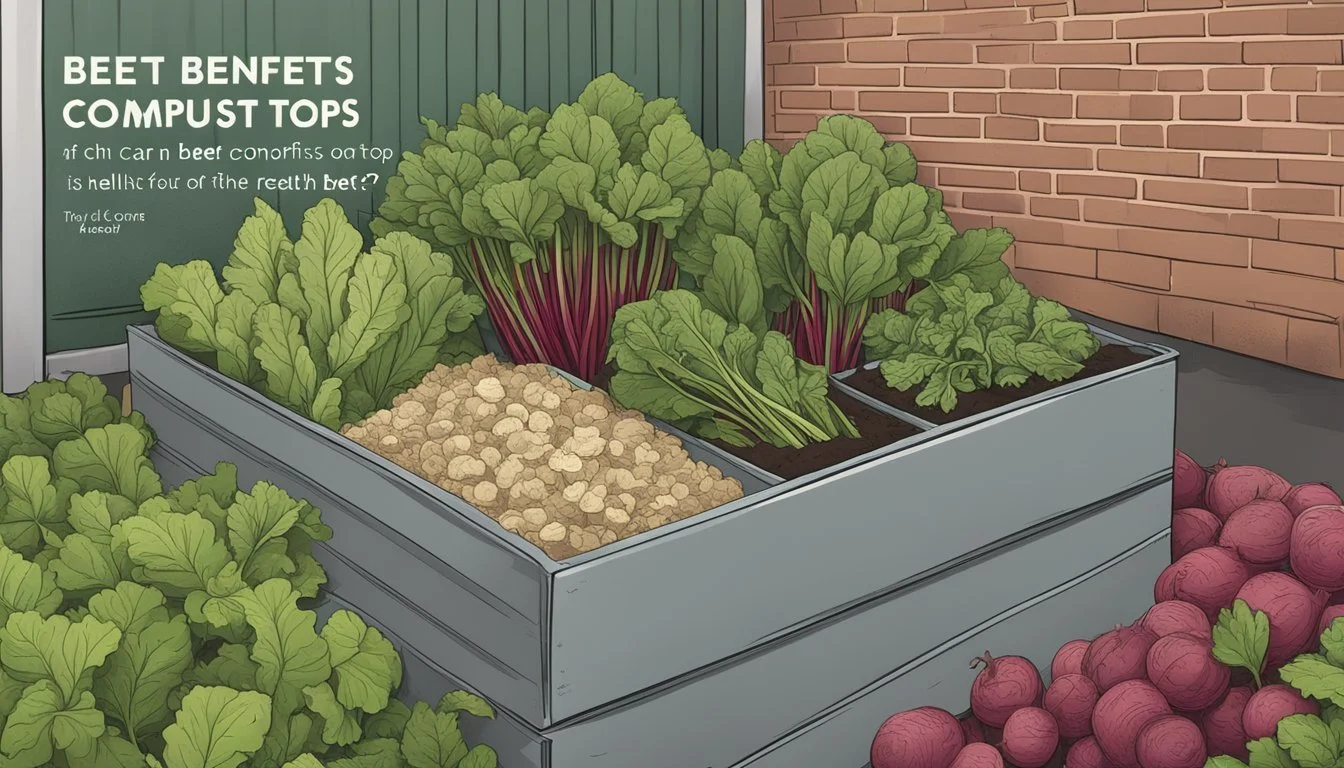Can You Compost Beet Tops?
Easy Guide to Recycling Kitchen Scraps
Composting is a sustainable practice that converts kitchen scraps and yard waste into nutrient-rich soil amendments, benefiting both gardens and the environment. Among various compostable materials, the subject of whether beet tops can be included in the compost pile often arises. Beet tops, including the leaves and stems, are organic matter that can decompose, making them suitable for composting. They add valuable nitrogen to the compost mix, helping to create a balanced compost that can enhance soil health and structure when used in gardens.
While beet tops can indeed be composted, certain considerations ensure the process is effective and problem-free. It is important to balance green materials like beet tops with brown materials, such as dry leaves or cardboard, to maintain the necessary carbon to nitrogen ratio. This balance aids in achieving efficient decomposition and avoiding odors that can arise from an overly nitrogenous compost pile. Moreover, chopping or tearing beet tops into smaller pieces before adding them to the compost can speed up the breakdown process, allowing for quicker conversion into compost.
Gardeners should also be mindful that while beet tops can be beneficial to a compost pile, not all parts of the kitchen waste are equally suitable for composting. Compost diversity is crucial, and including a variety of kitchen scraps ensures a rich and diverse microbial environment, resulting in high-quality compost. However, diseased plants or those heavily coated with pesticides should be avoided in compost to prevent potential harm to the resulting soil and plants it will nourish.
Benefits of Composting Beet Tops
Composting beet tops serves as a practical method to recycle valuable nutrients and enhance soil quality, while also contributing to waste reduction efforts. These leafy greens are not only organic matter but also a source of essential nutrients beneficial to the composting process.
Nutrient Recycling
Beet tops are rich in magnesium, an important nutrient that aids in the structuring of chlorophyll in plants. When composted, they return this magnesium to the soil, along with other nutrients like nitrogen, phosphorus, and potassium. Consequently, compost containing beet greens provides a balanced nutrient profile, essential for the growth of healthy plants.
Soil Improvement
Incorporating composted beet tops into garden beds significantly ameliorates soil structure. This organic addition improves soil aeration, water retention, and also introduces beneficial microorganisms that help with plant root development. Over time, consistent use of compost enriched with beet tops can lead to a more loamy, fertile soil, conducive to vegetable gardening.
Waste Reduction
By composting beet tops, households, and gardeners can actively decrease the amount of organic waste sent to landfills. This not only diminishes methane emissions from decomposing organic matter but also turns potential waste into a resource. Redirecting vegetable scraps into compost bins is a straightforward practice that contributes to more sustainable waste management.
How to Compost Beet Tops
Composting beet tops is an effective way to reduce waste and enrich garden soil. Through careful preparation and monitoring of the composting process, beet greens can be transformed into nutritious mulch for plants.
Preparation of Beet Tops
Before adding beet tops to the compost pile, ensure they are free from disease or rot. Diseased vegetation can infect the entire compost with pathogens. One should chop the beet greens into smaller pieces, which helps to accelerate the decomposition due to the increased surface area.
Composting Process
To compost beet tops, one should follow these steps:
Mix With Brown Material: Incorporate beet tops with dry, carbon-rich materials like leaves or shredded paper. This balance aids in maintaining an optimal carbon-to-nitrogen ratio.
Layering: Layer the beet tops with soil to help introduce microorganisms essential for the composting process.
Moisture and Airflow: Maintain adequate water levels to keep the heap moist but not waterlogged, and turn the pile regularly to ensure proper airflow.
Temperature Monitoring: Monitor the temperature of the compost pile since a temperature between 140°F and 160°F indicates that the materials are decomposing effectively.
pH Level Checks: Occasionally, check the pH level of the compost — it should stay near neutral for the best decomposition conditions.
Troubleshooting Common Issues
If the compost pile emits an unpleasant odor, this could signal excess moisture or lack of air. To counteract this, they should turn the pile to introduce more air and evaluate whether a cover is needed to protect from too much rain. If the compost appears too dry, adding water can reinvigorate the process. Keeping a proper balance of green and brown materials, alongside regular maintenance, helps prevent common compost issues.
Using Composted Beet Tops
Composted beet tops add valuable organic matter and nutrients to the garden. They can serve multiple purposes, from mulching to enhancing soil mixes for different gardening applications.
As Mulch
When used as mulch, composted beet tops provide a barrier against soil erosion and temperature fluctuations. In addition, the mulch retains moisture, benefiting plant roots. It slowly releases nutrients into the soil as it breaks down further, fostering a healthy soil ecosystem.
In Garden Soil Mix
Incorporating composted beet tops into a garden soil mix increases the organic matter content. This enhanced mix boosts the soil's nutrient profile and improves its texture, facilitating better root growth and water retention. Gardeners often blend compost into the top layer of soil to support vigorous plant development.
For Container Gardening
For those using containers, composted beet tops make an excellent addition to potting mixes. The compost provides a rich source of organic matter and nutrients, which are essential for plants grown in confined spaces. Since container gardens may lose nutrients quickly, the added compost helps sustain plant health over a longer period.
Growing Beets and Harvesting Tops
Growing beets (how long do beets last?) involves selecting the right variety, providing proper care, and harvesting the tops at the correct time to ensure both a healthy root and leafy greens for your table.
Beet Varieties
Beets (Beta vulgaris) come in several varieties, each suitable for different culinary uses and climate conditions. For example, 'Detroit Dark Red' is popular for its deep red roots and tender greens, while 'Chioggia' is known for its distinctive red and white striped roots and mild-flavored foliage. When choosing beet seeds, consider the variety's growth time and suitability for the intended harvest—both beet roots and beet greens.
Planting and Care
For successful growth, beets require a location with full sun and well-draining soil. The planting process involves sowing beet seeds directly into the garden soil, spacing them approximately 1 to 2 inches apart. It's crucial to keep the soil consistently moist until seedlings emerge. As they grow, thin the plants to about 3 to 4 inches apart to allow ample room for the root development. Beet plants benefit from regular watering and mulching to maintain soil moisture and temperature.
Harvesting Tops Safely
The foliage of beet plants, known as beet greens, can be harvested without damaging the root vegetable beneath. To safely harvest beet leaves, follow these guidelines:
Timing: Begin when seedlings are a few inches tall, usually 4 to 6 weeks after planting.
Method: Snip or pinch off the outer leaves, allowing the smaller, inner leaves to continue growing.
Frequency: Harvest sparingly, ensuring that the plant retains enough foliage to sustain the growing beet root.
Beet greens should be crisp and vibrant, indicative of their freshness and nutritional value. Beet greens can be used in salads or cooked dishes, offering versatility in the kitchen. By following these methods, gardeners can enjoy both the beet roots and leaves as part of a healthy, home-grown harvest.
Cooking with Beet Tops
Beet tops, the leafy green part of beetroot, are a versatile vegetable, packed with nutrients such as vitamins, iron, potassium, magnesium, and phosphorus. They can be innovatively used in a variety of recipes to enhance the flavor and nutritional value of meals.
Salads and Sides
Beet greens make a nutritious addition to any salad. They can be used fresh, similar to Swiss chard, adding a vibrant color and slight bitterness that pairs well with sweeter dressings. For a nutritious side dish, sautéed beet greens with garlic and a pinch of red pepper flakes (how long do red pepper flakes last?) offer a delicious eating experience. It is important to wash the greens thoroughly before use to remove any dirt. Combining them with nuts like almonds or walnuts can add a satisfying crunch and extra nutrients to the dish.
Beet Green Salad: Fresh beet greens, goat cheese, roasted nuts, vinaigrette
Quick Sautéed Beet Greens: Beet greens, garlic, olive oil, red pepper, salt, pepper
Main Dishes
Incorporating beet greens into main dishes such as soups and stews is a fantastic way to boost both the nutritional content and the flavor profile of these comfort foods. They can withstand long cooking times, which makes them ideal for such recipes. Beet greens can also be blended into a pesto as a twist on the traditional basil variety, adding a unique flavor to pasta and other dishes.
Beet Greens Soup: Chopped beet greens, vegetable broth, onions, carrots, seasoning
Beetroot Stew: Cubed beetroot, beet greens, potatoes, stock, bay leaves, thyme
Preservation Techniques
Preservation techniques allow for enjoying beet greens year-round. They can be pickled for a tangy condiment or steamed and then frozen for later use. Betalains, the pigments giving beet greens their color, are water-soluble and can leach out during the preservation process, so it's beneficial to use methods that minimize nutrient loss.
To pickle beet greens, use a simple brine of vinegar, water, sugar, and salt.
For freezing, blanch the greens briefly in boiling water, shock in ice water, drain, and then freeze.
These techniques not only extend the shelf life but also provide different ways to enjoy the earthy taste of beet greens in and out of beet season.
Problems and Pests Affecting Beet Tops
Ensuring the health of beet greens starts with understanding the issues that can arise. Beet tops, rich in nutrients, can be susceptible to a variety of pests and diseases which can compromise their vitality and, ultimately, their suitability for composting.
Common Pests
Beet greens can attract several types of pests. Key culprits include:
Aphids: These tiny, pear-shaped insects come in various colors and can severely damage beet tops by sucking sap from the leaves.
Leaf Miners: They create distinctive trails or tunnels inside beet leaves, which can lead to decay.
Flea Beetles: Small, jumping beetles cause holes by feeding on the leaves.
Proper care of beet tops involves regular pruning and thinning. This not only promotes healthy growth but also reduces the chances of pest infestation, which is common in over-crowded plantings.
Disease Management
Diseases can also affect beet tops, impacting their overall health:
Cercospora Leaf Spot: Look for brown spots with reddish-purple halos.
Downy Mildew: This appears as yellowish patches on the upper leaf surfaces and a downy growth underneath.
Good garden hygiene, including the removal of infected leaves and the avoidance of overhead watering, can help manage these diseases. For composting, only use healthy beetle tops to prevent the spread of pathogens through compost.
Health Benefits of Beet Tops
Beet tops, also known as beet greens, are the leafy parts of the Beta vulgaris plant. Nutritionally dense, they are often discarded despite their health benefits. A good source of essential vitamins and minerals, beet greens can be a healthy addition to any diet.
One of the standout nutrients in beet greens is vitamin K, which plays a crucial role in blood clotting and bone health. The leaves also contain significant amounts of vitamin A, acknowledged for maintaining healthy skin and vision. Additionally, beet greens provide vitamin C, an antioxidant that supports the immune system.
Minerals make up another important part of the nutritional profile of beet tops. They are rich in potassium, essential for proper nerve and muscle function, and in magnesium, which is involved in over 300 biochemical reactions in the body. Iron is present as well, a mineral vital for transporting oxygen in the blood.
Folate, a B vitamin, is especially plentiful in beet greens. It's necessary for DNA synthesis and repair, and also critical during periods of rapid growth such as pregnancy.
Here is a breakdown of the key nutrients in beet greens:
Nutrient Benefit Vitamin K Bone health and blood clotting Vitamin A Skin and vision health Vitamin C Antioxidant properties, immune support Potassium Muscle and nerve function Magnesium Supports biochemical reactions, nerve function Iron Oxygen transport in blood Folate DNA synthesis and repair, important for pregnant women
In conclusion, beet greens should not be overlooked. They are healthy greens, low in calories, and can easily be incorporated into one's diet. Cooking them can diminish certain nutrients, so it is often recommended to consume them lightly cooked or raw to maximize their benefits.
Environmental Considerations
Composting beet tops can lead to significant environmental benefits such as reduced water usage and a lower carbon footprint. These practices align with the sustainable management of organic waste, particularly for the Beta vulgaris species to which beets belong.
Water Usage
Beet leaves decompose naturally, turning into a nutrient-rich soil amendment that enhances water retention in soil. This process decreases the need for frequent watering as composted soil can hold moisture better than unamended soil. By facilitating better water use in agriculture, the natural decomposition of these organic materials supports more efficient and environmentally friendly food production.
Reducing Carbon Footprint
Composting beet leaves lessens the methane emissions that result from organic waste in landfills. By diverting this vegetable matter from waste streams and converting it into compost, it reduces the total greenhouse gas emissions. Furthermore, using compost enhances soil health, which in turn supports more robust plant growth and contributes to carbon sequestration, ultimately reducing one's carbon footprint.
Gardening Tips for Beets
Growing beets successfully encompasses both a solid planting approach and effective harvesting techniques. By optimizing these stages, gardeners can enhance both the quantity and quality of their beet yield.
Beet Planting Tips
Beets thrive in full sun and well-drained soil. For a successful planting:
Choose the right time: Beets are a cool-season crop and seeds should be sown when soil temperatures range between 50 to 85 degrees Fahrenheit.
Soil preparation: Ensure the soil is loose and free from stones. Beets require a neutral pH and benefit from well-rotated, nutrient-rich soil.
Spacing: Plant seeds about 1 inch apart in rows. For larger beet varieties, allow more space. Thinning is necessary once seedlings appear.
Container Options: Beets can grow in containers but choose ones at least 8 inches deep to accommodate the root bulb.
Watering: Provide consistent moisture, especially during seed germination and early growth.
Harvesting Techniques
To harvest beets:
Foliage Indicators: When beet leaves are sizeable, about 4-6 inches in height, the root typically is mature.
Timing: Harvest beets when they are about 1.5 to 3 inches in diameter. Larger specimens may become tough and woody.
Baby Greens: If desired, gently pluck a few new leaves for use in salads or as a side similar to spinach while the bulb continues to grow.
Continuous Harvest: Sow new seeds every 2-3 weeks for a longer harvesting season. This is particularly effective for varieties like 'Cylindra' which have elongated roots and are excellent for slicing.
Combine growing beets with other cool-season plants such as lettuce and herbs to make the most out of your garden's space.
Fun Beet Top Uses
While composting is an excellent way to utilize beet tops, these vibrant greens can also find a second life in creative and educational endeavors.
Crafts and Decor
Beet tops can be transformed into natural dyes, offering an eco-friendly option for coloring fabrics and crafting supplies. Their rich pigmentation lends itself well to creating striking red and pink hues. For a simple craft, one can dye a piece of cloth by boiling beet greens and soaking the fabric in the resulting liquid. Additionally, dried beet greens can be used in floral arrangements or as part of decorative wreaths, bringing a touch of organic beauty into one's home.
Educational Projects
Teachers and parents can employ beet tops for various educational projects that foster a connection to nature and understanding of plant biology. An engaging activity involves placing a beet top in a shallow dish of water placed in a sunny spot to observe and monitor how it re-grows. Documenting the growth stages offers a hands-on learning experience about plant regeneration for students. It can also lead to discussions on topics like photosynthesis, sustainable farming, and the concept of beeturia, the discoloration of urine following intake of beets, which can be a fascinating point of interest in science classes.
FAQs About Composting Beet Tops
Can beet tops be composted?
Yes, beet tops can and should be composted. They are an excellent source of organic material rich in magnesium, which benefits the soil's nutrient density.
Are beet tops good for compost?
Yes, beet tops enhance compost with essential minerals that help in developing healthy soil. Their contribution to the compost's nutritional value is highly regarded, particularly due to their nitrogen content beneficial for composting.
How do beet tops affect compost's pH level?
Beet tops are slightly alkaline; adding them to your compost should not significantly alter the pH level. The compost's balance depends on the variety of organic materials present.
What is the ideal way to compost beet tops?
For optimal results, gardeners should shred beet tops before adding them to the compost bin. This aids in quicker decomposition and even distribution of nutrients. Layering beet tops with brown compost materials, such as dried leaves or cardboard, ensures a balanced carbon to nitrogen ratio.
Mixing:
Combine beet tops with other kitchen scraps and yard waste.
Avoid compacting to ensure proper aeration.
Moisture:
Maintain moistness akin to a wrung-out sponge.
Overly wet conditions can lead to odor and slow decomposition.
What should not be composted with beet tops?
Avoid adding meat, dairy, oils, and diseased plants to the compost as these items can attract pests and inhibit the composting process.
Can composting beet tops be used to mulch plants?
After decomposition, the compost containing beet tops serves as a nutrient-rich mulch that supports plant growth and soil health. It can be spread around the base of plants to conserve moisture and suppress weeds.










